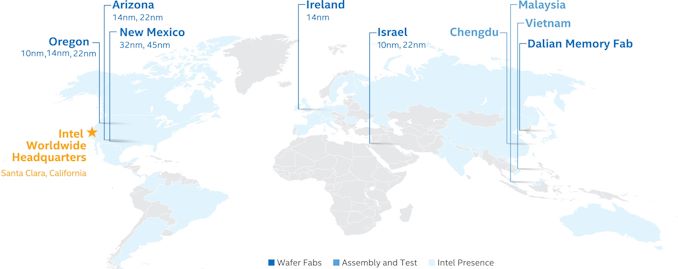Intel Details Plans for Its Oregon Fab Expansion: D1X Phase 3
by Anton Shilov on February 5, 2019 6:30 PM EST- Posted in
- CPUs
- Intel
- Semiconductors
Intel this week revealed the first details concerning its fab expansion plans in Oregon. As it turns out, the company intends to build the third phase of its D1X fab, and that the latest expansion (mod) will be similar in size to each of the first two phases of D1X. Intel plans to start construction later in 2019, so the new fab will be ready in the coming years.
As a part of its preparations to begin construction, Intel had to notify local residents about its intentions. On Monday the company contacted 50 residents living near its Ronler Acres campus about its intention to build a third phase of its D1X manufacturing facility. Just like the previous two buildings, the new fab will be approximately 1.1 million square feet (~102 thousand square meters) in size, according to a media report, but Intel yet has to disclose its official numbers. In addition to the factory, the company will have to build a new technology building with emergency generators, and utilities.
The processor giant has to disclose many more details about its D1X Phase 3 fab, including actual production capacity as well as process technology that it will use. Two of Intel’s fabs — in Israel and Oregon — are ready to produce CPUs and other products using the company’s 10 nm fabrication process, but it remains to be seen how much additional 10 nm capacity the company will need.
Intel announced plans to expand its production facilities in Oregon, Ireland, and Israel, in late 2018. A year before, it said it would furnish its Fab 42 in Arizona in a bid to build chips using its 7 nm process technology that relies on DUV and EUV lithography tools. Back in January 2019 it was also revealed that Intel also intends to build another massive fab in Israel.
Related Reading:
- Intel to Expand Production Capacities at Multiple Fabs
- Intel Considers $11 Billion Fab in Israel
- Israeli Parliament Approves Intel Fab 28 Expansion Grant
- Intel: EUV-Enabled 7nm Process Tech is on Track
- ASML to Ship 30 EUV Scanners in 2019: Faster EUV Tools Coming
Sources: OregonLive.com, Intel











24 Comments
View All Comments
ksec - Wednesday, February 6, 2019 - link
We never really knew why all of a sudden Intel plans to expand its Fab capacity when it should have started one or two years ago. Something was very dysfunctional during BK era.Korguz - Wednesday, February 6, 2019 - link
if intel wasnt trying to make so many cpu's.. maybe they wouldnt need to build or expand their fabs.....close - Wednesday, February 6, 2019 - link
Intel plans on investing almost $1bn in order to give US the C0X and D1X factories.Opencg - Thursday, February 7, 2019 - link
D1X phase 4 expansion in planning. Codenamed B1G D1X expansion.Rudde - Thursday, February 7, 2019 - link
Almost $1bn? Analysts estimate that the D1X expansion alone is more than $4bn.yankeeDDL - Wednesday, February 6, 2019 - link
Intel did not need to "think" or strategize for at least 6 years, having, de-facto, no competition to worry about.So they are in a very bad position, with CPUs that have made marginal progress under several aspects: not only performance, but also scalability. The Core architecture is not designed to scale to 8-16 core CPUs efficiently. I hope they have started now the development of a "really new" architecture, to go against Zen. If so, we'll see the benefits in 4-5 years. Hopefully. Competition is always good.
Gondalf - Wednesday, February 6, 2019 - link
You forget server cores are different from consumer, different caches, more vector units, different internal buses.Core arc is thinked for server and scalability from the beginning.
Your post has not common sense.
Zen arc is severely limited in scalability, in fact it has not success in four and eight sockets market.
The few Zen boxes sold are mainly single socket configurations....still right now the Epyc penetration Is so little that it is in the irrelevance territory.
Smell This - Wednesday, February 6, 2019 - link
SWING! ... and a miss (three times, in fact).You stuck-out, Cowboy.
raddude9 - Wednesday, February 6, 2019 - link
I'm not agreeing with the original poster, but your comment does not make much sense either.Mercury estimated that AMD had more than 3% share of the server market last year:
https://www.tomshardware.com/news/amd-market-share...
So the Epyc chips have already made significant gains in a market that is slow to more to new unproven platforms.
And you must not have seen AMD's upcoming 64 core 7nm Epyc chips if you think the Zen Arch. is "limited in scalability". 128 cores in a 2-socket server is going to be way more cores than the vast majority of 4 and 8 socket servers currently in use. So the reason why AMD "has not success in four and eight sockets market" is because they foresaw that you simply don't need expensive niche 4 and 8 socket machines to bring value to the server market.
IUU - Monday, February 11, 2019 - link
"So they are in a very bad position".I don't think so. Even when stepping on the break for 6 years as you say, and even staying behind in the manufacturing process, they are still faster in ST computing. Imagine that they are still faster(albeit by a small margin) even though they altrouistically went to vacations to help their "younger" but less skilled siblings (AMD,ARM) catch them.
As for the fact , that Intel was 1+ whole process ahead from everyone, and then they fell on successive failures to progress to smaller nodes, year after year, while other less experienced players managed to go on.... Well, it is the right of every person to hold their own beliefs.